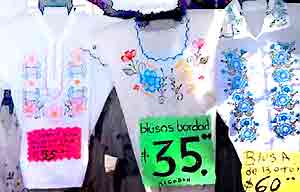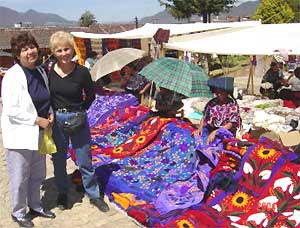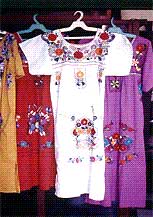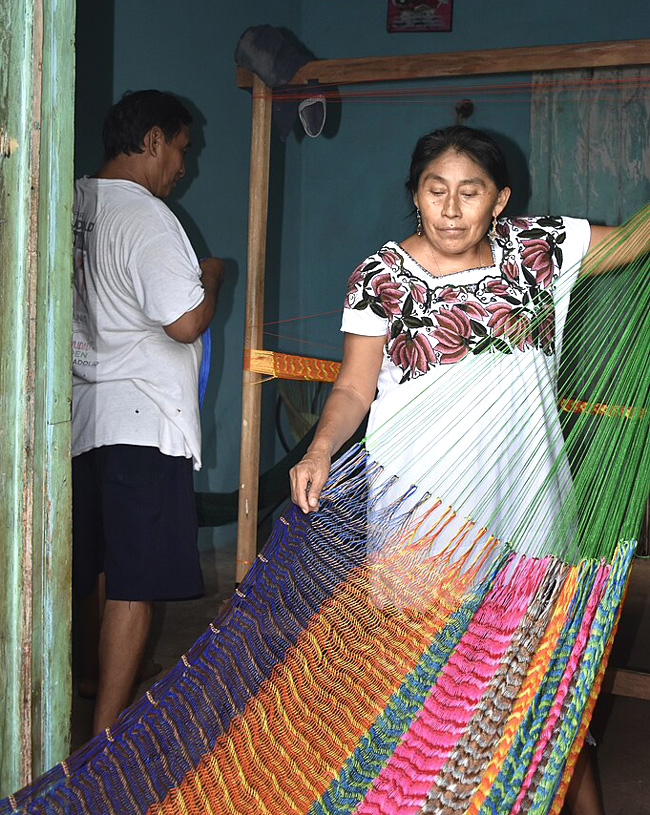
At a workshop in Oaxaca a carpet is woven using traditional geometric motifs seen in the nearby Mitla pyramids; this single piece can take several weeks to finish; copyright-free image courtesy of Alfredo Carmona made available through Wikimedia Commons.
It's sometimes said that the sophistication of ancient American indigenous cultures has been underestimated because much of their art was of the perishable kind. That's the case with woven textiles. Today Mexicans continue to weave traditional cloth masterpieces, a case in point being described in our meeting with Sr. Fidel Nava Medina, the serape maker in Gualupita Yanhuitlalpan, Mexico State, in our "Producers of Goods" section. When you buy textiles at Mexican mercados it's always interesting to ask where the textiles were actually made.

Shopping for textiles sold by Guatemalan women in San Cristobal, Chiapas. Photo courtesy of Cherry Bedenkop of Arizona
Though Sr. Nava was working with wool, and wool was introduced by the Spaniards, cotton was known to the ancients. The Aztec warriors who opposed the conquistadors as they invaded central Mexico wore armor incorporating cotton padding. This padding was effective against the weapons of other indigenous nations, but not against the blows of metal sabers and cannons used by the Spanish.

Mariana Gómez using a backstrap loom, sometimes called a belt loom, at an artist's compound outside Oaxaca city; copyright-free image courtesy of "David.Clay.Photography" made available through Wikimedia Commons.
Ancient Native Mexicans also had looms before the Spanish introduced European-style ones. They utilized backstrap looms such at the one shown above.

Traditional textiles for sale in Coyoacán market in Mexico City; copyright-free image courtesy of "Alondrapr" made available through Wikimedia Commons.
Though nowadays it's possible to find anything and everything woven to generic-tourist taste, many traditional textile products continue to be available in Mexico. Among the most-bought among tourists are roomy, prettily embroidered smock-like dresses such as the ones appearing to the right, and the embroidered blouses at the top of this page. Another basic item, a large rectangular piece with various designs woven into it, is the serape. Though only a few Mexicans still sling serapes over their shoulders, serapes are big tourist fare. They make excellent wall hangings and tablecloths.
In the Yucatán Peninsula, hamacas, or hammocks, continue to be woven in small Maya communities, often for sale to the Yucatan's growing tourist numbers. Hammocks can be purchased made of cotton, nylon, silk, and rough and scratchy henequen fiber. Three-ply ones are less likely to stretch and develop snapped strings than double- and single-threaded ones. Average-size Mexicans are shorter than most gringos, so sencillo hammocks designed for one person are typically too small for most tourists; the doble meant for two is usually just right. If you really like the idea of two-in-a-hammock, then buy familiares or matrimoniales especiales.

In Dzitnup, Yucatán, the señora weaves hammocks for the community and to sell; copyright-free image courtesy of "Acuareloman" made available through Wikimedia Commons.